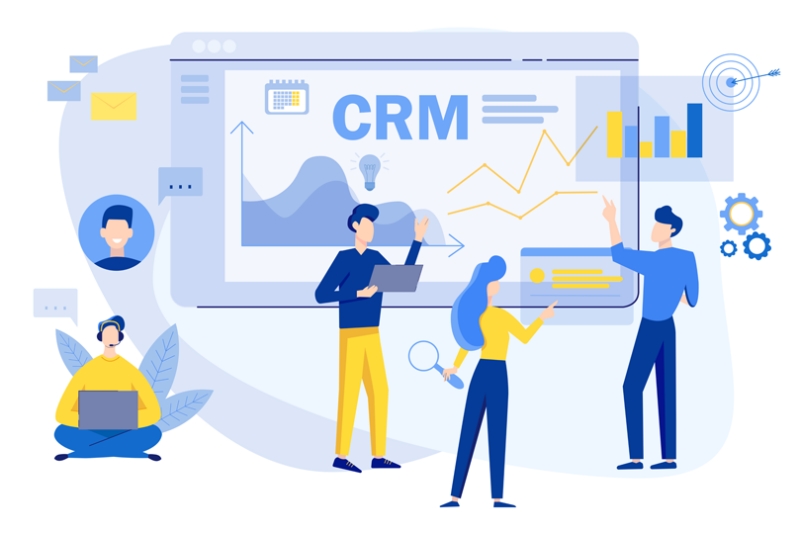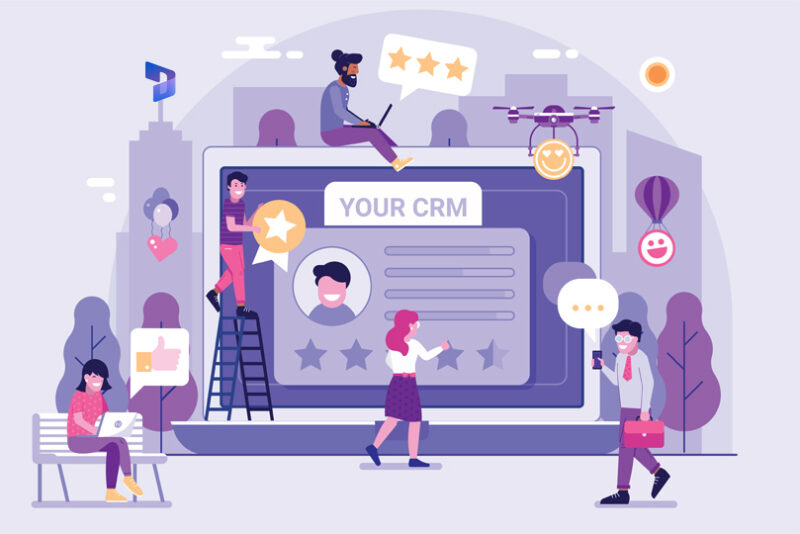If you are embarking on a project to implement a new CRM system, it’s crucial that your team can see early value from the technology to capitalise on this opportunity.
That’s because poor user adoption is consistently cited as the main reason why CRM projects fail to achieve their goals. When organisations focus only on completing the implementation project on time and within the budget, they risk failing to consider what’s required to secure end-user adoption.
Or, perhaps your organisation has already deployed Dynamics 365, but your team aren’t getting the most from it?
How can you ensure end-users embrace new CRM technology and keep them engaged so they continue deriving value in the long term? In this blog, we share 11 ways to strengthen Dynamics adoption.
Contact us today to discuss your situation and receive initial advice from our experts.
1. Secure buy-in from key business users.
A lack of consultation with user representatives in the early stages of CRM projects often causes adoption issues.
When key personnel are involved in these planning decisions, they can provide feedback on how the technology should be personalised to solve their team’s challenges.
They should participate in product demonstrations or trials to identify how the technology should be personalised. They’ll ask pertinent questions from a user perspective and provide feedback to steer project decisions. This way, the deployed system will be aligned with users’ expectations, and they’ll have a more significant stake in the project.
To ensure continuity, these individuals should remain involved from the planning phase and can potentially become super users once the system is live. By contrast, adoption issues are more likely if stakeholders frequently change during the project lifecycle because no one has a clear vision of what they want from the system.
2. Keep it simple!
An intuitive system makes user adoption easier. For example, your team may not need the complete set of functionality available in a specific Dynamics module. Avoid overwhelming end users with a cluttered sitemap and features they don’t need now. Prioritise what’s essential to drive early results.
If your team is struggling with a recently deployed system, consider how it can be personalised and where improvements can be made to improve their experience. One solution could be to use Power App Component Frameworks (PCF) controls that offer a more visual experience for interacting with their data. Examples include barcode scanners, toggle controls, number inputs, rich text controls, and ratings.
Suppose several user groups in your organisation use the same Dynamics application. In this scenario, they may find the site map challenging to navigate multiple tables and business processes. To simplify this, custom Dynamics apps can be deployed that only include the elements relevant to each workgroup.
3. Personalise the system.
To successfully meet the demanding standards of user relevancy, your Dynamics system must be personalised according to your specific workflows, terminology, and rules. This includes customising field titles and reports to align with your unique processes.
Additionally, it is essential to empower and motivate users to create and use their own personalised views and dashboards. These tailored resources will enable them to effectively manage the data significant to their tasks and responsibilities.
With the ability to add or remove fields on forms, modify dropdown values, or rename columns in tables, users can help shape the system to perfectly accommodate their needs and preferences.
4. Communication is key.
When implementing a new system, it is natural for team members to feel cautious and resistant to change. However, open and timely communication is vital in alleviating these concerns.
By communicating the impending changes early on, individuals are provided sufficient time to prepare, ask questions, and express concerns. Developing a comprehensive internal communication plan can help mitigate negative feelings. This plan should outline the specifics of the upcoming changes, the reasons behind them, the timeline for implementation, and the prerequisites for a successful transition.
It is important to note that a single communication attempt is not enough. Instead, communication should occur regularly and in stages to ensure that everyone comprehends the significance of the new CRM system.
To foster support and engagement, it is essential to illustrate how Dynamics will improve the daily work experiences for everyone. Emphasise the direct benefits the system can deliver to them.
For example, highlight how the system simplifies processes and automates repetitive tasks, leading to significant time savings in manual data handling. Using Dynamics, everyone can serve customers more efficiently and make well-informed decisions based on reliable data. Suppose your sales teams spend a considerable amount of time on administrative tasks. In that case, demonstrate how the automated functionalities of D365 Sales can empower them to reclaim valuable time, thereby boosting their productivity.
5. Begin with CRM 1.0.
Starting with a small-scale CRM implementation offers several advantages beyond cost reduction. By seeing early benefits, users can develop confidence in the application, which sets the foundation for successful adoption.
Implementing CRM in phases is a proven and effective strategy. It allows teams to master the fundamental functionality without feeling overwhelmed by an ambitious project that attempts to accomplish too much too quickly.
While it may be tempting to view the implementation as an opportunity to incorporate all available features at once, this approach poses risks to adoption and can impact project delivery timelines.
Instead, prioritise going live with a minimum viable product and introducing additional features to the application as needed. This iterative approach ensures smoother implementation and minimises the potential for disruption.
6. Provide adequate training.
When it comes to CRM user training, a one-size-fits-all approach falls short. Different user groups, such as sales and marketing teams, have distinct priorities and specific needs, and the training should be tailored accordingly.
In addition to basic user familiarisation, offering training that focuses explicitly on the functionality and processes relevant to each user group is essential. This targeted approach ensures that users receive training that directly addresses their unique requirements, enabling them to maximise the benefits of Dynamics 365.
While Dynamics 365 may have an intuitive interface, it also encompasses advanced functions and broader platform capabilities that require more in-depth training for users to leverage fully. This comprehensive training empowers everyone to explore the system’s full potential.
When onboarding remote employees, user adoption can present additional challenges. However, online training proves valuable in such scenarios. For example, Dynamics eLearning allows new users to gain confidence and proficiency swiftly through guided on-demand training modules. This interactive approach facilitates a self-paced learning experience, enabling users to apply what they learn directly to their work tasks.
7. Create a buzz.
The user adoption process goes beyond technical aspects, and injecting creativity can be highly beneficial.
For example, consider using gamification techniques to drive Dynamics adoption. We’ve seen instances of organisations instigating friendly competitions, incentivising people to create the most records. Displaying the results on a leaderboard adds a fun element to the project, fostering engagement and participation.
It is crucial not to overlook the importance of exciting individuals about using the new system rather than simply instructing them to do so. Project leaders should explore innovative and informal approaches to cultivate a sense of enthusiasm and engagement, leading to increased adoption.
8. Integrate to avoid duplication of efforts.
If you’ve already deployed Dynamics but find individuals are still switching between apps and struggling with data silos or manual processes, achieving CRM adoption becomes more challenging. To address this, it is crucial to identify opportunities for integrating Dynamics with other applications such as Outlook, Teams, marketing automation services, accounting systems and other critical systems. Only through integration can everyone fully benefit from connected data and seamless processing.
Furthermore, it is essential to recognise the need to eliminate reliance on legacy spreadsheets or other applications where data management and connectivity can be improved using Dynamics.
By implementing a fully integrated solution, teams gain more time to focus on their core responsibilities, improving efficiency. This approach also helps prevent users from perceiving CRM as another disconnected system that adds to their workload.
9. Use CRM data in meetings.
Leaders should demonstrate their CRM system usage as much as they want their teams to adopt it. Quote CRM data and use these metrics as the basis for reporting, discussing and celebrating the achievement of goals.
For example, a service team leader can share Dynamics 365 Customer Service data to report how many cases were logged last month, commend the individuals who resolved the most issues and pinpoint which problems are consuming the most time.
This approach cultivates a culture of data-driven decision-making, where insights from the CRM system become a cornerstone for informed discussions, goal tracking and recognising achievements.
10. Data management.
Effective data management is crucial for the success of any system. Before data migration, it is essential to eliminate duplicate and outdated contacts to ensure that only trusted and high-quality data is imported.
Duplicates, inaccuracies, or missing records undermine trust and confidence in the system, rendering its insights meaningless. Implement controls and checks to enforce data standards and accuracy to maintain data integrity after the initial import.
For example, consider adding a field in the Dynamics record to track the last contact details update. This prompts users to verify the accuracy of customer information when communicating and update it if necessary.
We have implemented a Data Retention Policy solution for several customers. This tool tracks why records are stored in Dynamics 365 and identifies any that may potentially be removed. By using this solution, organisations can ensure compliance with data protection laws and extract greater value from their data. Designate a champion who will oversee these activities and foster a culture of periodic data cleansing.
11. Review usage and make continuous improvements.
Dynamics is a long-term investment, and it requires ongoing refinement to achieve optimal results. Leaders should establish clear and measurable goals and consistently review usage against these benchmarks to ensure sustained adoption.
While early signs of engagement may be positive, without proper monitoring, there is a risk of users reverting to old ways of working. If adoption is low among certain individuals or user groups, encourage open expression of concerns, assess the validity of these issues, and take swift action to regain their confidence.
It is crucial to foster a culture of feedback and actively encourage employees to provide input on desired changes or additional features that would add value to the application. We can help you to implement these enhancements and make sure your system evolves in line with user-driven change.
Stay informed about the regular product updates released by Microsoft, as they may introduce new features to enhance your Dynamics system. Provide familiarisation training as necessary to keep users up to date with these updates and maximise their benefits.
By continually monitoring, refining, and responding to user feedback and staying abreast of product updates, you can ensure that your system remains dynamic, adaptable and aligned with your organisation’s evolving needs and goals.
CRM User Adoption: Next Steps.
CRM user adoption can present challenges, but you don’t have to tackle them alone.
Whether you are considering Dynamics 365 as a new CRM solution or encountering difficulties with an existing system, we are here to support you at every step.
If you are facing issues with the quality of support from your current partner or believe that your system is not fully utilised, our Dynamics 365 managed service launch consultancy will help you regain momentum. We will work closely with you to address gaps, optimise your system, and get things back on track.
Our team is dedicated to providing the assistance and expertise you need to overcome obstacles, drive user adoption, and unlock the full potential of your Dynamics system. With our guidance, you can confidently navigate the complexities of CRM adoption and achieve the desired outcomes for your organisation.
Contact us today to speak to one of our team, discuss your requirements and receive initial advice.





